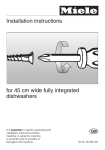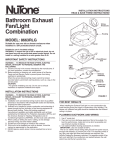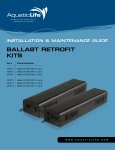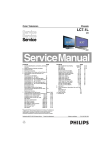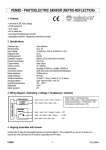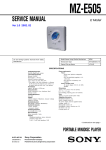Download Miele G 653 Plus Technical data
Transcript
Installation instructions for 60 cm wide fully integrated dishwashers It is essential to read the operating and installation instructions before installing or using the machine, to avoid the risk of accident or damage to the machine. G M.-Nr. 05 585 951 These installation instructions apply to several different dishwasher models. Model numbers in this booklet refer to the model designation specified on the data plate on the machine (and not the description on the control panel). The data plate is located on the right hand side of the door when open. The model numbers quoted refer only to the basic model number, e.g. the G 643SC-Vi is described as the G 643. It is essential to read the "Warning and Safety Instructions" in the Operating Instruction booklet before installing the dishwasher. 2 Contents Installation . . . . . . . . . . . . . . . . . . . . . . . . . . . . . . . . . . . . . . . . . . . . . . . . . . . . . . . 4 Opening the door. . . . . . . . . . . . . . . . . . . . . . . . . . . . . . . . . . . . . . . . . . . . . . . . . . . 4 Opening the door when the fixing bracket has been taken off: . . . . . . . . . . . . . 4 Building in dimensions. . . . . . . . . . . . . . . . . . . . . . . . . . . . . . . . . . . . . . . . . . . . . . . 5 1. Fitting protective cover plate to worktop . . . . . . . . . . . . . . . . . . . . . . . . . . . . . . . 6 2. Building the dishwasher into a niche . . . . . . . . . . . . . . . . . . . . . . . . . . . . . . . . . . 9 Dishwasher height . . . . . . . . . . . . . . . . . . . . . . . . . . . . . . . . . . . . . . . . . . . . . . . 9 Slides . . . . . . . . . . . . . . . . . . . . . . . . . . . . . . . . . . . . . . . . . . . . . . . . . . . . . . . . . 9 Securing pieces . . . . . . . . . . . . . . . . . . . . . . . . . . . . . . . . . . . . . . . . . . . . . . . . 10 3. Fitting the matching door front. . . . . . . . . . . . . . . . . . . . . . . . . . . . . . . . . . . . . . 12 4. Adjusting the door front . . . . . . . . . . . . . . . . . . . . . . . . . . . . . . . . . . . . . . . . . . . 16 5. Securing the dishwasher . . . . . . . . . . . . . . . . . . . . . . . . . . . . . . . . . . . . . . . . . . 17 6. Adjusting the door springs . . . . . . . . . . . . . . . . . . . . . . . . . . . . . . . . . . . . . . . . 18 7. Matching the plinth facia of a kitchen run . . . . . . . . . . . . . . . . . . . . . . . . . . . . . 19 Electrical connection . . . . . . . . . . . . . . . . . . . . . . . . . . . . . . . . . . . . . . . . . . . . . . 20 Plumbing. . . . . . . . . . . . . . . . . . . . . . . . . . . . . . . . . . . . . . . . . . . . . . . . . . . . . . . . 22 Connection to the water inlet . . . . . . . . . . . . . . . . . . . . . . . . . . . . . . . . . . . . . . . . . 22 Drainage . . . . . . . . . . . . . . . . . . . . . . . . . . . . . . . . . . . . . . . . . . . . . . . . . . . . . . . . 23 Venting the drainage system . . . . . . . . . . . . . . . . . . . . . . . . . . . . . . . . . . . . . . 23 Special accessories . . . . . . . . . . . . . . . . . . . . . . . . . . . . . . . . . . . . . . . . . . . . . . . 24 Technical data . . . . . . . . . . . . . . . . . . . . . . . . . . . . . . . . . . . . . . . . . . . . . . . . . . . 25 3 Installation This dishwasher is specially designed for integration under a worktop run in a fitted kitchen. Opening the door – The front of the dishwasher is designed to take a front panel. It can be fitted with a base unit door front to match the rest of the kitchen. – The dishwasher does not have a plinth facia. The plinth area of the dishwasher needs to be covered either with a plinth facing to match the kitchen furniture or with one which can be ordered as a special accessory. The separate plinth facia can be height adjusted to suit the kitchen. The plinth return is freely adjustable. ^ Hold one corner of the upper fixing bracket and pull towards you (small arrow). Instructions for installing the dishwasher are described in the following sections. Opening the door when the fixing bracket has been taken off: ,To ensure stability, these dishwashers must only be installed under a continuous worktop which must be securely screwed to neighbouring units. ,The dishwasher must not be installed under a hob. The high radiant temperatures which are sometimes generated by a hob could damage the dishwasher. ^ Insert your finger into the T-shaped opening in the door opener and pull the door open. 4 Installation Building in dimensions Dishwasher models G 843 - G 863 Dishwasher models G 643 - G 663 1) Machine height 890 mm 2) Machine height 840 mm 1) Machine height 870 mm 2) Machine height 820 mm Adjustment range approx. 5 cm (82 -87 cm total height). Extended machine feet are available at extra cost, (special accessory) where a machine height of 87 to 92 cm is required. Adjustment range approx. 5 cm (84 - 89 cm total height). Extended machine feet are available at extra cost, (special accessory) where a machine height of 89 to 94 cm is required. 5 Installation 1. Fitting protective cover plate to worktop The plexiglass relfector panel and all other installation items required are included in the accessories pack supplied with the dishwasher. Wood or laminate worktops: The underside of the worktop is protected against steam rising from the machine by a special cover plate. A plastic holder is located on the left hand side of the cover plate for the dishwasher’s control light reflector panel. ,If two different materials meet up at the front edge of the worktop, then the join must be concealed by the cover plate. ^ Remove the protective backing from the cover plate. When the dishwasher is built-in, the left hand side of the reflector panel must be sited above the in-operation light in the dishwasher control panel. The procedure for fitting the reflector panel will depend on the type of worktop. On wood and laminate worktops the reflector panel is fitted together with the protective cover plate. The reflector panel is fitted without the protective cover plate on granite and marble worktops. 6 ^ Squeeze sealant from the tube supplied all the way along the hollow moulding in the cover plate. Installation ^ Align the cover plate to the front edge of the worktop in the middle of the niche. If the worktop has a very rounded edge, pull the cover plate further forward so that the reflector panel is still visible later on. ^ Press the reflector panel into the plastic holder in the cover plate. ^ Use the tacks supplied to nail the cover plate to the underside of the worktop. Worktops with wood or laminate edging: Nail the tacks through the holes further back from the edge. ^ Use soapy water to wipe off any excess sealant. 7 Installation Granite or marble worktops: Worktops made from hard materials such as granite or marble do not need the cover plate for protection. The cover plate is only used as a guide for marking the position for the reflector panel plastic holder. ^ Stick the doublesided adhesive strip supplied onto the back of the plastic holder. Keep the cover plate in case the dishwasher is ever fitted under another type of worktop. ^ First, remove the protective foil covering the plastic holder for the reflector panel and then take the holder out of the cover plate. ^ Remove the protective foil from the adhesive strip and stick the holder to the underside of the worktop at the marked position. ^ Align the cover plate to the front edge of the worktop in the middle of the niche. Draw around the cut-out for the plastic holder. If the worktop has a very rounded edge, pull the cover plate further forward so that the reflector panel is visible later. 8 ^ Press the reflector panel into the plastic holder. Installation 2. Building the dishwasher into a niche Connection to water and drainage should be sited beside and not behind the dishwasher for accessibility. Connections are usually made in the area under the sink. Many kitchen unit manufacturers provide a cut-out in the base of the sink base unit for the hoses to be fed through. If the base unit has no opening and if there is not an opening through the plinth area for connections, one must be cut. Dishwasher height ^ Adjust the height manually before installing the dishwasher. Leave a space of approx. 5 mm below the worktop to allow the dishwasher to be pushed back easily into the recess. Make sure that the dishwasher stands level. It is easier to adjust the screw feet if the weight of the dishwasher is not bearing down on them. If possible tip the machine slightly. Slides You will find the slides in the upper basket of the dishwasher. They make installation of the dishwasher easier and protect the floor from possible damage when moving the appliance into and out of the recess. They are also used for adjusting the height of the rear screw feet. Suggested dimensions: 60 x 110 mm. ,There must be no electrical sockets behind the dishwasher. Danger of overheating and fire risk if the dishwasher were to be pushed up against a plug. ^ Fit the slides - with the ratchet at the rear - under the screw feet. 9 Installation Securing pieces To ensure stability, the dishwasher must be fixed securely to the worktop (step 5). Two securing pieces are supplied for this purpose. ^ Push the dishwasher right back into the recess. Ensure that the drain hose, inlet hose and the electric cable are laid to reach the connection point without any kinks. ^ Fit the securing pieces into the slots on both the left and right hand sides. Granite and marble worktops: With these worktops the dishwasher must be securely screwed to neighbouring units on the right and left hand sides. For this you will require two special fixing brackets (these are included in the accessory pack together with fitting instructions and screws). Angle support The angle support for the water drainage hose at the rear of the dishwasher can be turned. ^ Turn the angle support in the direction of the on-site connection for the drainage hose. 10 Make sure that the left side of the reflector panel is sited above the in-operation light in the dishwasher control panel. To check, switch on the dishwasher, select a programme and close the door. The light is visible when the dishwasher has been aligned correctly. If it does not light up re-align the dishwasher in the niche. Installation Rear screw feet Front screw feet ^ Use a TORX T20 screwdriver to adjust the rear screw feet to the required height. ^ Adjust the front screw feet manually or with a flat blade screwdriver. Higher = turn clockwise Lower = turn anti-clockwise Several turns are needed to adjust 1 mm in height. Now adjust the feet until the seal on the top of the dishwasher is right up against the underside of the worktop, to which it will be screwed later. Ensure that the dishwasher stands level. 11 Installation 3. Fitting the matching door front The front of the dishwasher needs to be fitted with a base unit front to match the kitchen furniture. This door front may be a single panel or a two-piece panel, divided to give a dummy drawer facia line. ,The weight of the door front will affect the functioning of the door springs. After fitting it is essential for this to be checked out. See Step 6. Dimensions: Width: to match the door of a 60 cm wide base unit. Total height: Height of a full base unit front, or with a two-piece panel, height of shorter unit front plus gap plus dummy drawer facia. Thickness: 18 mm in the areas where the fixing bracket is screwed on. A fixing bracket must be fitted to the rear of the door front panel. This is then used for attaching the door front panel to the door outer panel on the machine. When the dishwasher is delivered the fixing bracket is secured to the dishwasher. To remove it: A door handle must be fitted to the front of the door front before the fixing bracket is fitted. Position the door handle to match others in the kitchen. It should be at drawer height in the centre of the panel. ^ Loosen the fixing screws (see thin arrow) on each side of the machine outer door panel. The door handle fixing screws must be countersunk, to avoid any protrusions at the rear of the door front. 12 ^ Open the dishwasher door slightly. ^ Push the fixing bracket upwards off the sprung bolts and remove. Installation Dimension X must be calculated and noted before attaching the fixing bracket. Dimension X is the distance shown on the illustration between the drill hole in the machine outer door panel and the lower edge of the neighbouring unit door. ^ Push the dishwasher into the recess and adjust the height. Fitting the fixing bracket to a door front ^ Lay the door front down with the rear side facing upwards. Draw a vertical line down the middle of the door front rear to use as a guide line. ^ Mark dimension X onto the rear of the door front, up from the bottom edge. With two-piece panels: If the two-piece panel is joined by non-flush fixings these must be removed. The fixing bracket supplied with the dishwasher can be used to secure both pieces. Make sure that the combined height worked out is retained. ^ Calculate dimension X. 13 Installation There are notches on the fixing bracket, marked a in the illustration. ^ Lay the fixing bracket on the rear of the door front, using dimension X for the distance from the bottom, and so that the notches marked a in the middle of the fixing bracket align with the vertical guide line, (see diagram). 14 ^ If necessary pre-drill holes for the screws (Ø 2.5 mm, approx. 10 mm deep). ^ Screw the fixing bracket on securely. Only one screw is required in each of the four upper pairs of holes on the fixing bracket. Installation Fitting the door front The door front is correctly fitted when: – the lower lugs on the fixing bracket rest firmly in the lower slits of the dishwasher outer door panel, ^ Hang the door front so that the lower lugs of the fixing bracket fit into the lower slits of the dishwasher outer door panel, and draw slightly upwards. – the prongs of the fixing bracket lie on the sprung bolts in the upper corners of the dishwasher door, – the recess in the middle of the fixing bracket fits securely in the T-shaped opening in the door opener. ^ Open the dishwasher door slightly. ^ Slide the prongs of the fixing bracket over the sprung bolts and press into place. ^ Press the front panel against the door and downwards, so that the prongs grip behind the sprung bolts. 15 Installation 4. Adjusting the door front ^ Close the dishwasher door. When fitted the door front can be adjusted up to a maximum of 2 mm upwards or downwards to match adjoining unit fronts. ^ Check the alignment of the door panel again. ^ Open the dishwasher door slightly. ^ If it is not correctly aligned you may need to loosen the screws and readjust it to the correct alignment. Once satisfied that the alignment is correct: ^ Open the dishwasher door. ^ Tighten all fixing screws (upper screws, TORX T20) at the sides. ^ Plug fixing screw and height adjustment screw recesses with the plastic stoppers supplied. ^ With the door open, press the front panel on one side against the door outer panel. ^ Adjust the height of the door front on this side using the lower recessed adjusting screw (TORX T20). higher = turn clockwise lower = turn anti-clockwise ^ Then secure the door front on this side by tightening the upper recessed fixing screw (TORX T20) at the side of the machine door outer panel. ^ Repeat the process on the other side of the door. 16 Installation 5. Securing the dishwasher ^ Open the dishwasher door. The holes in the securing pieces must line up with the long holes in the worktop cover plate. If this is not the case, adjust the position of the dishwasher in the niche (ensure that the dishwasher is the same distance from the neighbouring kitchen units on the right and left hand sides and line the dishwasher door front up with neighbouring door fronts). ^ Screw the countersunk screws (3.9 x 22) supplied upwards through the securing pieces on the left and right hand sides into the work surface to secure the dishwasher. Ensure that the seal on the top edge of the dishwasher fits directly against the worktop. If this is not the case, adjust the height adjustable feet some more (see step 2). 17 Installation 6. Adjusting the door springs ^ Half open the dishwasher door. The door springs are correctly adjusted when the door remains stationary when left open at 45 °. The door springs are easier to adjust when the door is only half open than when it is fully open. If the door drops down, then the door springs need to be tightened. If it closes then the springs need to be loosened. The adjusting screw is located in the upper front strip at the left hand side of the dishwasher. Please note: If the the door front is too heavy for the door springs (i.e. the door falls open) then stronger springs should be fitted. Please contact your Miele dealer or the Miele Spare Parts Department for advice. 18 ^ Adjust the door spring with a Torx T20 or a 1 x 5.5 mm screwdriver until it is correctly balanced: - Turn clockwise = tighten - Turn anti-clockwise = loosen. Installation 7. Matching the plinth facia of a kitchen run ^ Place the plinth facia directly in front of the kitchen run but do not attach. The plinth area of the dishwasher is normally covered with a plinth run matching the kitchen furniture. ^ Carefully open the dishwasher door. If the door front comes into contact with the kitchen plinth when the dishwasher door is opened the plinth facia in the area behind the dishwasher door needs to be cut to size. ^ To do this mark where the edge of the door front comes into contact with the plinth facia. ^ Cut the plinth facia to size along this line. The height (H) of the plinth facia in front of the dishwasher depends on the plinth return (R) and how much the door front extends below the dishwasher door (P). ^ Place the plinth facia in front of the kitchen run again and check whether the dishwasher door can be opened fully. If it cannot, trim the plinth facia again until to the correct size is achieved. ^ Secure the plinth facia to the adjacent kitchen units in accordance with kitchen furniture manufacturer’s instructions. If your kitchen does not have a plinth run matching the kitchen furniture, the plinth area can be covered with a separate plinth kit, available at extra cost (special accessory). 19 Electrical connection ,Please follow the installation instructions carefully. All electrical work should be carried out only by a suitably qualified and competent person, in strict accordance with national and local safety regulations. Ensure power is not supplied to the appliance while installation work is being carried out. This dishwasher is supplied with a mains cable and moulded plug ready for connection to an a.c. single phase supply, (230 -240 V 50 Hz for the UK and Australia) via a fused plug and suitable switched socket which is easily accessible after installation. ^ The voltage, rated load and fuse rating are given on the data plate located on the right hand side of the door. Please ensure that these match the household mains supply. For extra safety it is advisable to install a residual current device (RCD), with a trip current of 30 mA (in accordance with DIN VDE 0664, VDE 0100 Section 739). ^ Do not connect via an extension lead. Danger of overheating. ,If the connection cable is dam- aged it must be replaced with a complete connection box and cable by a Miele approved service technician only. Important If this machine is fitted with a non-rewireable plug (BS 1363) and the socket outlets are not suitable for the plug supplied or if the existing plug needs to be replaced by a new one, the old plug will need to be cut off and an appropriate plug fitted. The fuse carrier and the fuse should be removed from the old plug and disposed of. The plug cut from the cable should then be disposed of and on no account be inserted into any socket elsewhere in the house (electric shock hazard). The fuse cover must be refitted when changing the fuse, and if the fuse cover is lost, the plug must not be used until a suitable replacement is obtained. The colour of the correct replacement cover is that of the coloured insert in the base of the plug, or the colour that is embossed in words on the base of the plug (as applicable to the design of plug fitted). The correct fuse rating of the replacement fuses that are ASTA approved to BS 1362 should be fitted. Replacement fuse covers may be purchased from your local electrical supplier or Miele Service Agent. 20 Electrical connection The wires in the mains lead are coloured in accordance with the following code: Green/yellow = earth Blue = neutral Brown = live If the colours of the wires in the mains lead of this appliance do not correspond with the coloured markings identifying the terminals of your plug, proceed as follows: ^ The wire which is coloured green and yellow must be connected to the terminal in the plug which is marked with the letter E or by the earth symbol z or coloured green, or green and yellow. ^ The wire which is coloured blue must be connected to the terminal in the plug which is marked with the letter N or coloured black. ^ The wire which is coloured brown must be connected to the terminal in the plug which is marked with the letter L or coloured red (UK), or marked with the letter A (AUSTRALIA). WARNING: THIS APPLIANCE MUST BE EARTHED 21 Plumbing Connection to the water inlet ,Water in the dishwasher must not be used as drinking water. – The dishwasher may be connected to a cold or hot water supply, max. 60 °C. When connected to a hot water supply all programme stages which would otherwise be carried out with cold water (pre-wash and interim rinse) as well as the Pre-wash programme will be carried out with hot water. On models with recirculation condensation drying please note that if your dishwasher is connected to a hot water supply drying results may be impaired. – The inlet hose is approx. 1.5 m long; a longer hose (4 m), or a 1.5 m long flexible metal hose tested to withstand pressure of 140 bar may be bought from the Miele Spare Parts Dept. If the water pressure is too high, a pressure reducer valve must be fitted. ,The water inlet hose must not be shortened or damaged in any way, (see illustration). – A stopcock with a 3/4 " male thread must be provided on site. – The dishwasher is constructed to comply with DVGW regulations, and may be connected to a suitable supply without an extra non-return valve if national regulations allow this. – The water pressure (flow pressure at the take-off point) must be between 0.3 and 10 bar. If the water pressure is too low the Water "inlet" or "inlet / drain" light (depending on model) may light up, (see "Problem solving guide" in the Operating Instruction booklet). 22 If the stopcock is situated in the worktop, a special angle connector can be ordered from the Miele Spare Parts Dept. (Part No. 04 274 820). Plumbing Drainage Venting the drainage system – The machine drainage system is fitted with a non-return valve, which prevents dirty water from flowing back into the machine via the drain hose. ^ Open the dishwasher door fully. – The dishwasher is supplied with an approx. 1.5 m long flexible drain hose with an internal diameter of 22 mm. – The drain hose can be extended using a connection piece and an extra drain hose, (up to max. 4 metres). If the site drain connection is situated lower than the guide path for the bottom basket rollers in the open door the drainage system must be vented. Otherwise a siphoning effect during a programme can cause the machine to empty itself of water. To vent: – A hose clip is supplied for connecting the drain hose to the on-site drainage outlet. – The connection socket on the dishwasher can be turned. The hose can thus be laid to the right or left without needing to loosen the hose clip supplied. – The drain system must not exceed 4 metres. The drain pump has a maximum delivery head of 1 metre. – The on-site water pipe connection for the drain hose may be designed to fit more than one diameter of hose. The connection socket must be shortened if it juts too far into the drain hose. Otherwise the drain hose can become blocked. ^ Cut off the top of the vent valve in the wash cabinet. – The drain hose must not be shortened. – Ensure that the drain hose is laid so that it is free from kinks. 23 Special accessories You would like to... Then you need... ... build the dishwasher into a kitchen which does not have a matching plinth run ...a separate plinth kit available in: white black ... adjust the height of the dishwasher to ...kit with extended machine feet between 87 cm and 92 cm (G 643 - G 663) or between 89 cm and 94 cm (G 843 - G 863) 24 Technical data Dishwasher model G 643 G 843 Height 81.7 cm (adjustable + 5.0 cm) 83.7 cm (adjustable + 5.0 cm) Height of building in recess 82 cm (+ 5.0 cm) 84 cm (+ 5.0 cm) Width 59.8 cm 59.8 cm Width of building in recess 60 cm 60 cm Depth 57 cm 57 cm Depth with door open 115.5 cm 120.5 cm Weight Fully integrated Fully integrated SC model # approx. 52.5 kg approx. 54 kg approx. 54.5 kg approx. 56 kg Voltage Rated load see data plate on the right hand side of the open door Fusing Test marks VDE, Radio and Television suppressed VDE, Radio and Television suppressed Water pressure (flow pressure) 0.3 - 10 bar pressure 0.3 - 10 bar pressure Hot water connection max. 60 °C max. 60 °C Delivery head max. 1 m max. 1 m Drainage length max. 4 m max. 4 m Connection cable approx. 1.7 m approx. 1.7 m Capacity 12 place settings 14 place settings # SC = Dishwasher with cutlery tray 25 Technical data Dishwasher model G 653 - G 663 G 853 - G 863 Height 81.7 cm (adjustable + 5.0 cm) 83.7 cm (adjustable + 5.0 cm) Height of building in recess 82 cm (+ 5.0 cm) 84 cm (+ 5.0 cm) Width 59.8 cm 59.8 cm Width of building in recess 60 cm 60 cm Depth 57 cm 57 cm Depth with door open 115.5 cm 120.5 cm Weight Fully integrated Fully integrated SC model # approx. 53.5 kg approx. 55 kg approx. 55,5 kg approx. 57 kg Voltage Rated load see data plate on the right hand side of the open door Fusing Test marks VDE, Radio and Television suppressed VDE, Radio and Television suppressed Water pressure (flow pressure) 0.3 - 10 bar pressure 0.3 - 10 bar pressure Hot water connection max. 60 °C max. 60 °C Delivery head max. 1 m max. 1 m Drainage length max. 4 m max. 4 m Connection cable approx. 1.7 m approx. 1.7 m Capacity 12 place settings 14 place settings # SC = Dishwasher with cutlery tray 26 27 Alteration rights reserved (NovoPlus Vi60) / 1003 M.-Nr. 05 585 951 / V00 This paper consists of cellulose which has been bleached without the use of chlorine.




























